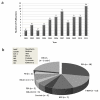Cancer imaging: Gene transcription-based imaging and therapeutic systems
- PMID: 22349219
- PMCID: PMC3324783
- DOI: 10.1016/j.biocel.2012.02.001
Cancer imaging: Gene transcription-based imaging and therapeutic systems
Abstract
Molecular-genetic imaging of cancer is in its infancy. Over the past decade gene reporter systems have been optimized in preclinical models and some have found their way into the clinic. The search is on to find the best combination of gene delivery vehicle and reporter imaging system that can be translated safely and quickly. The goal is to have a combination that can detect a wide variety of cancers with high sensitivity and specificity in a way that rivals the current clinical standard, positron emission tomography with [(18)F]fluorodeoxyglucose. To do so will require systemic delivery of reporter genes for the detection of micrometastases, and a nontoxic vector, whether viral or based on nanotechnology, to gain widespread acceptance by the oncology community. Merger of molecular-genetic imaging with gene therapy, a strategy that has been employed in the past, will likely be necessary for such imaging to reach widespread clinical use.
Copyright © 2012 Elsevier Ltd. All rights reserved.
Figures


Similar articles
-
Preclinical applications of imaging for cancer gene therapy.Expert Rev Mol Med. 2006 Jul 14;8(16):1-19. doi: 10.1017/S1462399406000044. Expert Rev Mol Med. 2006. PMID: 16842637 Review.
-
Gene therapy and imaging in preclinical and clinical oncology: recent developments in therapy and theranostics.Ther Deliv. 2014 Dec;5(12):1275-96. doi: 10.4155/tde.14.87. Ther Deliv. 2014. PMID: 25531929 Review.
-
Intratumoral versus intravenous gene therapy using a transcriptionally targeted viral vector in an orthotopic hepatocellular carcinoma rat model.J Vasc Interv Radiol. 2012 May;23(5):704-11. doi: 10.1016/j.jvir.2012.01.053. Epub 2012 Mar 2. J Vasc Interv Radiol. 2012. PMID: 22387029 Free PMC article.
-
Noninvasive molecular imaging using reporter genes.J Nucl Med. 2013 Feb;54(2):167-72. doi: 10.2967/jnumed.111.099788. Epub 2013 Jan 14. J Nucl Med. 2013. PMID: 23318292 Review.
-
Combination of pet imaging with viral vectors for identification of cancer metastases.Adv Drug Deliv Rev. 2012 Jun 1;64(8):749-55. doi: 10.1016/j.addr.2011.04.007. Epub 2011 Apr 30. Adv Drug Deliv Rev. 2012. PMID: 21565234 Review.
Cited by
-
Detecting Tumor Metastases: The Road to Therapy Starts Here.Adv Cancer Res. 2016;132:1-44. doi: 10.1016/bs.acr.2016.07.001. Epub 2016 Aug 17. Adv Cancer Res. 2016. PMID: 27613128 Free PMC article. Review.
-
Tumor-specific expression and detection of a CEST reporter gene.Magn Reson Med. 2015 Aug;74(2):544-9. doi: 10.1002/mrm.25748. Epub 2015 Apr 27. Magn Reson Med. 2015. PMID: 25919119 Free PMC article.
-
A Unique Core-Shell Structured, Glycol Chitosan-Based Nanoparticle Achieves Cancer-Selective Gene Delivery with Reduced Off-Target Effects.Pharmaceutics. 2022 Feb 7;14(2):373. doi: 10.3390/pharmaceutics14020373. Pharmaceutics. 2022. PMID: 35214105 Free PMC article.
-
Molecular Imaging with Reporter Genes: Has Its Promise Been Delivered?J Nucl Med. 2019 Dec;60(12):1665-1681. doi: 10.2967/jnumed.118.220004. J Nucl Med. 2019. PMID: 31792128 Free PMC article. Review.
-
A survivin-driven, tumor-activatable minicircle system for prostate cancer theranostics.Mol Ther Oncolytics. 2021 Jan 20;20:209-219. doi: 10.1016/j.omto.2021.01.007. eCollection 2021 Mar 26. Mol Ther Oncolytics. 2021. PMID: 33665359 Free PMC article.
References
-
- Bhaumik S. Advances in imaging gene-directed enzyme prodrug therapy. Current pharmaceutical biotechnology. 2011;12:497–507. - PubMed
Publication types
MeSH terms
Substances
Grants and funding
LinkOut - more resources
Full Text Sources
Medical
Miscellaneous

